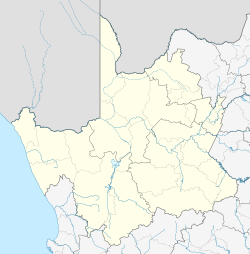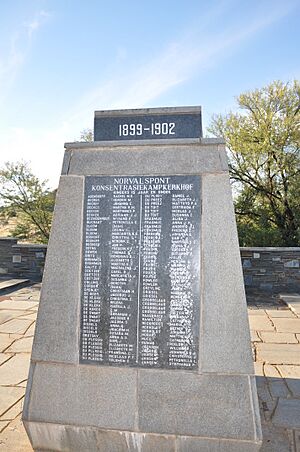Norvalspont facts for kids
Quick facts for kids
Norvalspont
|
|
|---|---|
| Country | South Africa |
| Province | Northern Cape |
| District | Pixley ka Seme |
| Municipality | Umsobomvu |
| Established | 1848 |
| Area | |
| • Total | 0.9 km2 (0.3 sq mi) |
| Population
(2011)
|
|
| • Total | 1,198 |
| • Density | 1,330/km2 (3,450/sq mi) |
| Racial makeup (2011) | |
| • Black African | 91.7% |
| • Coloured | 7.8% |
| • Indian/Asian | 0.3% |
| • White | 0.0% |
| • Other | 0.1% |
| First languages (2011) | |
| • Xhosa | 86.3% |
| • Afrikaans | 8.7% |
| • Sotho | 3.2% |
| • Other | 1.8% |
| Time zone | UTC+2 (SAST) |
| PO box |
9797
|
| Area code | 051 |
Norvalspont is a small town in the Northern Cape province of South Africa. Its name means Norval’s ferry in Afrikaans. It was named after a clever Scottish person who built a ferry here in 1848. The town is located on the southern bank of the Orange River, just below the Gariep Dam.
In the late 1800s, Norvalspont became an important stop on the Noupoort – Bloemfontein railway line. The first bridge across the Orange River was built in 1889. This bridge helped British soldiers and their horses cross the river during their first campaign against the Voortrekkers. Before the bridge, people and goods had to use a ferry to cross. This first bridge was later damaged by a flood.
Norvalspont was also home to a large concentration camp for Afrikaner women and children during the Second Boer War.
Norvalspont and the Anglo-Boer War
Boer soldiers took control of the railway bridge on November 1, 1899. They then moved into the Cape Colony. As the British army fought back, the Boers blew up the railway bridge. They destroyed three of its main parts on March 5, 1900.
A few days later, a British engineer began building a temporary pontoon bridge. This bridge allowed soldiers on foot and horseback to cross the river into the Orange Free State. By the end of March, a temporary railway bridge was also built. After the war, the original railway bridge was changed into a road bridge.
You can still find signs of the Anglo-Boer War, also known as the Second Boer War, in Norvalspont. These include British stone shelters (sangars) and a blockhouse along the riverbank. The blockhouse has been turned into a home with a garden that goes down to the river.
Norvalspont Concentration Camp
The Norvalspont concentration camp was set up in November 1900. It was created to help ease the overcrowding at the Bloemfontein camp, which had a water shortage. This camp, used during the Anglo-Boer War, was first led by Lieutenant St John Cole Bowen.
The camp was located in the Cape Colony. It was part of the larger group of concentration camps in the Orange River Colony. At first, the camp held Afrikaner women and children. By February 1901, about 400 prisoners were held here. In June 1901, hundreds of Bantu people were also brought to the camp.
By February 1902, the camp had 3,479 residents. This number had grown from about 3,000 in June 1901. A school opened at the camp by the end of July 1901. It taught 500 children.
Life in the Camp
Because the camp was on the banks of the Orange River, it had plenty of water. At first, there was also a good supply of wood from the river bushes. Residents lived in white tents. Initially, only five people shared each tent. However, later on, tents became very crowded.
At first, fresh meat, milk, fruit, and vegetables were given to residents. But by January 1901, due to overpopulation, only meat and flour were provided. When conditions were better, the camp had a shoe shop. It provided a pair of shoes for everyone living there. Clothes were also given to those who arrived without any.
Soon after the camp was set up, a measles epidemic broke out. Many people also got scarlet fever and diphtheria. Records of deaths in the camp only started in January 1901. By July of that year, it is believed that 412 people had died in the camp.
Reports from British camp doctors about the conditions, including Norvalspont, often blamed the poor health of children on a lack of cleanliness among the Boers. However, historians have pointed out that these suggestions often tried to shift blame away from the doctors' own responsibility for the camp's poor hygiene.
Even a hundred years later, you can still see where the tents were placed. This is because of the original paving made from empty food and milk tins. A memorial was put up in the local cemetery to honor those who died in the camp.




